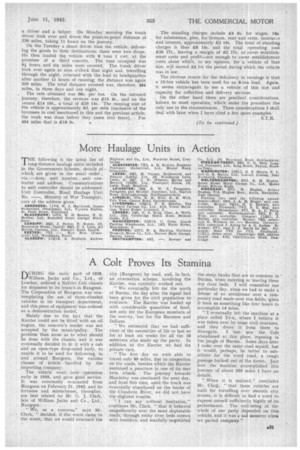A Colt Proves Its Stamina
Page 33

If you've noticed an error in this article please click here to report it so we can fix it.
DI–NURING the early part of 1938. L./William Jacks and Co., Ltd., of London, ordered a Helder Colt chassis for shipment to its branch in Rangoon. The Corporation of Rangoon was contemplating the use of three-wheeled vehicles in its transport department, and this piece of equipment was ordered as a demonstration model.
Mainly due to the fact that the Karrier could not be fitted'with an oil engine, the concern's tender was not accepted by the municipality. The problem then arose as to what should be done with the chassis, and it was eventually decided to fit it with a cab and an open-type drop-sided body, to enable it to be used for 'delivering, in and around Rangoon, the various classes of article handled by the _importing company.
The . vehicle went into operation early in 1939, and gave good service. It was eventually evacuated from Rangoon on February 21, 1942, and its fortunes and misfortunes, thereafter, are best related by Mr. G. J. Clark, late of William Jacks and Co., Ltd., Rangoon. We, as a concern," says Mr. Clark, " decided, if the worst came to the worst, that we would evacuate the city (Rangoon) by road, and, in fact, an evacuation scheme, involving the Harrier, was carefully worked out.
" We eventually left for the north of Burma, the day after the signal had been given for the civil population to eviEuate. The Harrier was loaded up with considerable quantities of food, not only for the European members of the convoy, but for the Burmese and Indians.
" We estimated that we had sufficient of the necessities of life to last us for at least six weeks for all the 18 members who made up the party. in addition to the Harrier we had Six private cars.
" The first day we were able to travel only 80 miles, due to congestion on the roads, besides which the Harrier Sustained a puncture in one of its rear twin wheels. " The journey towards Mandalay was continued the next day, and from this time, until the truck was eventually abandoned on the banks of the Chindwin River, we did not have the slightest trouble. •
" I can say without .hesitation," continues Mr. Clark, " that it -behaved magnificently over the most deplorable roads, 'through rocky river beds strewn with boulders, and manfully negotiated the steep banks that are so common in ' Burma, when entering or leaving these dry river beds. I well remember one particular day, when we had to make a detour of an aerodrome o'er a temporary road made over rice fields, when it took us something like four hours to accomplish 14' miles.
" I eventually left the machine at a place called Ye-n, where I believe it was taken over by sonae civil evacuees, and they drove it from there to Shwegyin. I last sew the Colt abandoned at . this place, reposing in the jungle of Burma. Some days later I came over the same road myself, but it would, perhaps, be better to substitute for the word road, a rough passage backed out of the forest. Just how the machine accomplished this journey of about 250 miles I have no details, " When it is realized," concludes Mr. Clar4," that these vehicles are built for travelling over smooth city streets, it is difficult to find a word to express oneself sufficiently highly of its performance. The well-being of the whole of our party depended on this vehicle, and it was a sad moment when
we parted company." .




















































